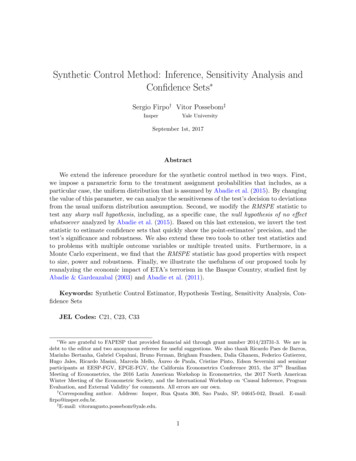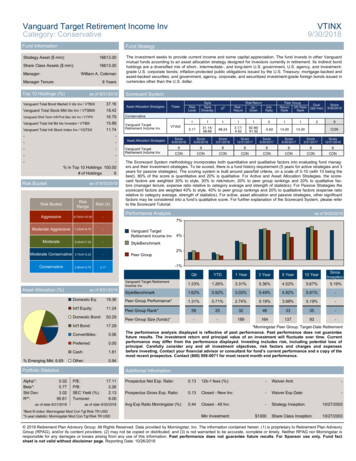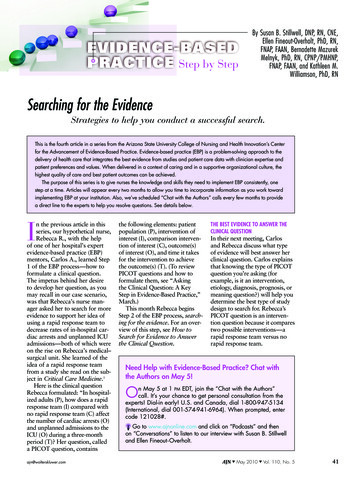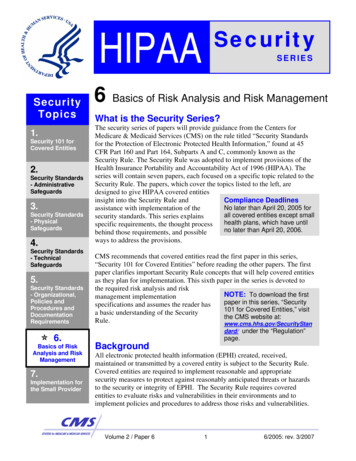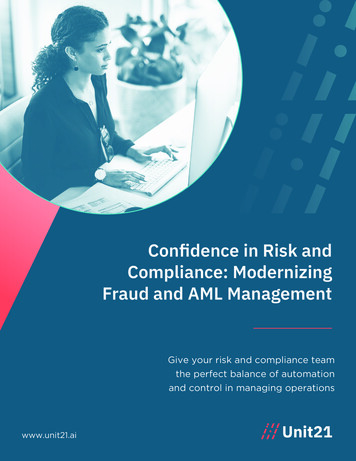
Transcription
Confidence in Risk andCompliance: ModernizingFraud and AML ManagementGive your risk and compliance teamthe perfect balance of automationand control in managing operationswww.unit21.ai
ContentsOverview31. IntroductionThe Rising Tide of Regulation44The Costs of Non-ComplianceUNIT215Why Should Fintech and Blockchain Care AboutFinancial Crime? Fintech and Online Marketplaces Cryptocurrency and DeFi Crime6662. FRAML as an Approach — Unifying Fraudand AML Management83. Fraud and AML’s Unique ObstaclesCurrent Solutions and Their Shortcomings Legacy Solutions Homegrown Solutions Newer Software Solutions1010101011Visibility into Fraud and AML Too Many Datasets and Programs Too Many False-Positives121212Risk and Compliance Operators are Far-Removedfrom their Solutions Reliance on IT Engineering Manual, Manual, Manual1414144. How Unit21 Approaches FRAML155. How Unit21 Empowers Fraud and AML Teams20Customer StoriesIntuitBakkt2324Conclusion25CONFIDENCE IN RISK AND COMPLIANCE: MODERNIZING FRAUD AND AML MANAGEMENT2
OverviewFraud and money laundering continue to increase in scale, speed andsophistication — threatening the revenue and growth of financial teams.This ebook outlines: The alarming rate at which bad actors are tapping into new outlets forfraud and money laundering, and the need for a more robust defense. How organizations can benefit from an integrated approach to fraudand AML (Anti-Money Laundering) to gain more visibility and addresstheir shared goals. How to future-proof teams by balancing automation and control, andputting Risk and Compliance technology in the hands of practitionersthemselves; not engineering.The ebook also showcases how two financial services leaders are usingUnit21’s no-code and customizable platform to combat fraud and moneylaundering.UNIT21CONFIDENCE IN RISK AND COMPLIANCE: MODERNIZING FRAUD AND AML MANAGEMENT3
1IntroductionThe Rising Tide of RegulationFor every 1 of fraud,companies lose 3.36in chargebacks andreplacement andoperational costs.With 90% oflaundered moneygoing undetected, it isdifficult to gauge theactual rate of growth.Financial firms are dealing with unprecedented regulation and complexity.Regulatory announcements associated with fraud and AML have increasedby more than 500% globally, which has led to 10-15% of total staff offinancial organizations working under compliance functions. Risk management teams report spending up to 10% of revenue on compliance. As aresult, globally, 213.9 billion per year is spent on maintaining financialcrime compliance, which is growing at nearly 29%.1This rising tide of regulation can be attributed to two increasing criminalforces: Fraud and Money laundering.Fraud. Fraud is a costly and growing problem. For every 1 of fraud,companies lose 3.36 in chargebacks and replacement and operationalcosts. Identity fraud losses soared to 56 billion in 2020. Fraudsterscontinue to increase the scale, speed and sophistication of attacks —from 2020 to 2021, fraud grew at an average of 33% — threatening therevenue and growth of companies.2Money Laundering. Meanwhile, globally money laundering is on the risewith the pandemic. With 90% of laundered money going undetected, it isdifficult to gauge the actual rate of growth. The UN estimates that up to 4 trillion is laundered annually.3 Launderers are increasingly counting oncommunication gaps between banks, while governments continue to try andaddress the threat with increasingly strict, multi-layered AML regulations.What is more worrisome is that organized crime groups have advancedtheir tactics. In recent years, there has been an increase in fraud andmoney-laundering via: 123UNIT21Creation of synthetic identities using bots and cyberattacksPhony e-commerce sites posing as online stores or payment providersThe use of virtual cryptocurrenciesMachine learning models to game traditional compliance systemsTrade-based and cross-border .htmlCONFIDENCE IN RISK AND COMPLIANCE: MODERNIZING FRAUD AND AML MANAGEMENT4
Financial services lose revenue due to fraud. In the case of laundering,they lose more than just money and have to answer to the governmentwhen they are not compliant.The Costs of Non-ComplianceA 2020 EuropeanCorporate GovernanceInstitute report showsthat stock price reactions of negative presswere 9x larger thanthe penalties.The consequences of non-compliance are multifaceted. In 2020, AML finesexceeded USD 10 billion globally, an 80% increase over the prior year.In 2020, the SEC issued 715 enforcement actions, ordering violators topay upwards of 4.68 billion combined. For example, in 2021, FinCEN(Financial Crimes Enforcement Network) issued Capital One with penaltiesof 390 million for failure to report thousands of suspect transactions.4The costs of non-compliance go beyond fines. On average in a year, a financial organization can lose up to a total of 15 million for the consequences of non-compliance — that is 2.71xhigher than what firms typically pay to stay compliant. A 2020 European Corporate Governance Institute report shows thatstock price reactions of negative press were 9x larger than the penaltiesas they erode the brand, and reputation.5The Costs of CE IN RISK AND COMPLIANCE: MODERNIZING FRAUD AND AML MANAGEMENT5
In our brand-conscious times, companies want to avoid having any association with organized crime, terrorist groups, or other criminal syndicatesinvolved in fraud and money laundering. Compliance lapses indicateinsufficient due diligence on new clients, subpar management of fraudand AML programs, poor transaction monitoring.Cryptocurrency-basedcrime hit an all-timehigh of 14 billionin 2021.Why Should Fintech and BlockchainCompanies Care About Financial Crime?Fintech and Online MarketplacesFintechs and marketplace companies are subject to the same regulations,sanctions and fines as established financial institutions. Unfortunately,they don’t have the Risk and Compliance infrastructure and headcount oflarge banks. Additionally, these smaller counterparts typically don’t interact with their customers in-person, which complicates the ID verificationprocess. These smaller teams must meet the compliance requirements ofa sponsor bank that may not have visibility into the fintech’s data. Othercompanies such as marketplaces and sharing-economy platforms facesimilar challenges, even though they don’t directly engage in any financialservices.Cryptocurrency and DeFi CrimeWith the increasing use of cryptocurrency, financial crime has found a newavenue. Cryptocurrency-based crime hit an all-time high of 14 billionin 2021.6 Already, fraud is the dominant cryptocurrency crime, followedby theft. Based on blockchain technology, decentralized finance (DeFi)is the up and coming threat for fraud and money laundering. In fact DeFihacks and fraud are on the rise as shown below.DeFi-related hacks saw a 2.7x increase in 2021 from 11641500073CONFIDENCE IN RISK AND COMPLIANCE: MODERNIZING FRAUD AND AML MANAGEMENT6
DeFi Hacks and Fraud are Rapidly Increasing to More Than 330M Per Quarter 300M 250M 200MDeFi hacks and fraud quarter-to-quarter,Source: Cryptocurrency Crime andAnti-Money Laundering Report, August2021, CipherTrace 150M 100M 50MSource: CipherTrace Cryptocurrency IntelligenceFinCEN, Financial Action Task Force (FATF), and other regulatory bodies acknowledge that blockchaintechnology carries significant risks that we need to be wary of.In 2020, 50% of crypto theft, totalling 118.73 million, were DeFi-related hacks. Also, in 2020, USexchanges sent 379 million of Bitcoin (BTC) directly to criminals. One third of cross-border Bitcoinvolume is sent to exchanges with weak KYC (Know Your Customer).7Money launderers and fraudsters existed before the advent of cryptocurrency. As theworld adopts blockchain more widely, new problems will arise. The SEC, CommodityFutures Trading Commission (CFTC), and IRS have all started asserting regulatorycontrol in the space. For example, the CFTC also has authority to regulate crypto as acommodity. The IRS has also stated that cryptocurrency investments are assets that willbe treated like any other for tax purposes. Still, new capabilities and analytics may makeit easier to capture bad actors and allow law enforcement professionals to examinecritical cases. As crypto scams and fraud become more common, it will be important forfinancial organizations to help authorities with ONFIDENCE IN RISK AND COMPLIANCE: MODERNIZING FRAUD AND AML MANAGEMENT7
FRAML as an Approach — UnifyingFraud and AML ManagementFRAML is an approachto fraud and AMLthat lets financialinstitutions addressboth holistically.2Looking at various financial organizations, AML and Anti-Fraud are separate.AML is often led by a Chief Compliance Officer and anti-fraud is oftenoverseen by a Chief Risk Officer. Traditionally, they view their objectivesas separate, despite the two performing similar work centered arounddetecting suspicious patterns, investigating system-generated alerts,and identifying criminal activity. The emergence of FRAML — i.e. Fraud AML — reflects both the increase and interconnectedness of fraud andmoney laundering. FRAML is an approach to fraud and AML that letsfinancial institutions address both holistically. Fraud management teamsand AML teams have three objectives in common: Finding and addressing suspicious anomalous transactions Shielding customers and organizations from financial crime Maintaining regulatory complianceThere is a major opportunity for fraud and AML teams to align behindthese shared objectives. Both teams can share customer data — usinga unified system to collaborate and share cases, while independentlydoing their own analyses.For financial organizations, there are major benefits to using a FRAMLapproach: Cost Savings. Bringing these two teams into operational alignment ismore cost-effective than having two disparate teams. More Visibility into Financial Crime. When the fraud managementand AML teams work using the same tool, they get a broader anddeeper perspective of the threats the organization faces. New Capabilities for Both Fraud and AML Teams. When fraud andAML teams share their tools, they empower one another and cancollaborate on cases. Fraud teams may discover anomalous transactionsthat may need to be flagged for AML, and vice versa.UNIT21CONFIDENCE IN RISK AND COMPLIANCE: MODERNIZING FRAUD AND AML MANAGEMENT8
70% of banks arelooking to achieve[fraud and AML]synergies within theIncreasing rates of financial crime are pushing teams to look at FRAMLas an integrated approach with a shared end-to-end view, shared data,and a shared set of tools. Collaborating throughout the complianceand fraud value chain — from KYC and transaction monitoring to casemanagement — financial services can increase visibility into fraud moneylaundering structures. Sharing information gives the ability to betterunderstand schemes and better detect and prevent financial crimes.A study by BAE Systems reports that 70% of banks are looking to achievesynergies within the next three years, and that North American banksare typically more mature in their approach to tackling financial crime,driven by the strength of technology platforms.next three years.UNIT21CONFIDENCE IN RISK AND COMPLIANCE: MODERNIZING FRAUD AND AML MANAGEMENT9
Fraud and AML’s Unique Obstacles3FRAML is easier said than done. With a variety of different tools, theoutcomes can differ. More importantly, there are a few key roadblocksthat are shared below:Current Solutions and Their ShortcomingsWhen you go the “build”route, engineeringeffectively becomesthe business’sbottleneck.Legacy SolutionsThe transaction monitoring space for Risk and Compliance has long beendominated by legacy, on-premise providers. The software is selected byIT and Engineering departments who have control, not the complianceteam. These types of implementation can take a year or more and haveslow time to market. False-positive rates sometimes exceed 90%, withtraditional rules systems’ used by legacy compliance solutions.The total cost of legacy platforms is also prohibitive for many smallerfinancial companies. Too often, AML activities are only performedperiodically due to inefficiencies in processes and competing priorities.(For example, fraud solutions often get higher priority because they canprevent actual losses for a company.)In addition, legacy solutions are limited in monitoring and analyzing largevolumes of data from all daily transactions. They cannot ingest externaldata to provide the insights needed for a comprehensive assessment of risk.These shortcomings can lead to suspicious activities going undetected.Homegrown SolutionsLegacy and homegrown builds may offer customization capabilities, butneed more upfront work and investment. And even when implemented,they may not achieve what they are intended to do and require furtherinterventions for customizations that come at the cost of time and resources.People who have built compliance tools in-house will testify that buildingwill always take substantially longer, while the cost is exponentially higheras compliance is not their core business. The result may be a customizablebut less-scalable solution for both current and future needs. What’s moreis, when you go the “build” route, engineering effectively becomes theUNIT21CONFIDENCE IN RISK AND COMPLIANCE: MODERNIZING FRAUD AND AML MANAGEMENT10
business’s bottleneck. There is also a disconnect between what anoperator knows vs. what engineering is building for them. This createsdifficulty in optimizing workflows and resources. In such situations,customization comes at a cost and distances Risk and Compliance teamsfrom their solution.Newer Software SolutionsThere are modern players in the fraud and AML space, many of whichhave more user-friendly interfaces than older incumbents. However, theyare not flexible enough to codify the company’s logic and rely on vendorsor engineering teams for any support or updates. Fraud and AML aremultifaceted but they focus mostly on transactions, providing a limitedview. Additionally, they still require coding and involve teams to undertakerepetitive manual tasks in processes such as Suspicious Activity Report(SAR) filing if they want to report wrongdoing. They also lack deepstatistical analysis to tap into insights and do not solve for the gapbetween the people on the frontline who know the scenarios and rulesneeded, and the engineering teams who have to build them. Some toolsoffer black-box products with rules and models that leverage MachineLearning (ML) and Artificial Intelligence (AI). Black-box models may seemadvanced and appealing, but there is little visibility into what is going onbehind-the scenes — making it difficult for analysts to explain theirdecisions to stakeholders and regulators. While ML-based systems canbe useful and drive automation, they take away control from Risk andCompliance teams to iterate on their own rules and models.The Problem with Black-Box ModelsBlack-Box AIUNIT21CONFIDENCE IN RISK AND COMPLIANCE: MODERNIZING FRAUD AND AML MANAGEMENT11
Visibility into Fraud and AMLToo Many Datasets and ProgramsThere are often separate BSA (Bank Secrecy Act) and fraud departmentsthat manage different software programs and execute their own sets ofprocesses. This has led to operational inefficiencies where data is lostand anomalies are not properly identified. Providing critical data acrossmultiple systems is a key first step for any fraud and AML surveillanceprogram. This can be a beast when financial services receive low- tohigh-risk data from billions of transactions across different branches,and countries.Consolidating this data is a huge barrier even the most sophisticatedorganizations struggle with. Fraud and BSA analysts often resort tomanually compiling data to perform analysis and the siloed data makesit difficult for comprehensive analysis. Transactional data is often held innumerous legacy systems, making it difficult to connect the information,limiting the effectiveness of Risk and Compliance analysis. Financialorganizations often use different vendors for KYC, transaction monitoringand case management. This means management needs to deal withmultiple contracts and checks, while Risk and Compliance teams haveto inconveniently toggle between different systems to detect and manageanomalous transactions.Using multiple vendors can lead to inconsistent data, disparate views andmake operators prone to errors — in addition to the higher costs of installingand managing several systems. Additionally, when trying to govern andtrace back data and analytics for regulators, the trails may be obscuredusing the different systems. Visibility is important to audit and organizationshave to find ways for better data governance and transparency.Too Many False PositivesYou will not find any content on this topic that does not mention falsepositives. Compliance alert systems based on standard regulatory technology are triggering thousands of false positives every day. ForbesUNIT21CONFIDENCE IN RISK AND COMPLIANCE: MODERNIZING FRAUD AND AML MANAGEMENT12
reports that with false-positive rates sometimes exceeding 95%, something is broken with legacy complianceprocesses. Each of these false alarms must be reviewed by a Compliance Officer, which invites opportunitiesfor inefficiency and human error. In traditional rule-based immutable AML models, the simpleness leadsto large volumes of false positives. False positives erroneously disguise actual illegitimate activity. Thedirect cost alone of reviewing false positives is in the billions. Analysts investigate around 20-30 falsealerts a day — decreasing productivity and capacity to focus on high-risk cases. High-volume, low-valuealerts overwhelm Risk and Compliance teams.Financial organizations have to reach out to their provider for rule-tuning, putting additional pressure onefficiency and response times. This results in higher operational costs and just higher frustration amongstanalysts. In fact, AML false-positives can cost financial organizations over 3 billion every year.8 Incumbentsolutions additionally have a limited view of transaction trails whereas there are several non-monetarydata streams such as user behaviors, entities and third-party data sources that may provide useful context.Such tools provide a limited foundation for anomaly detection. In addition, incumbent systems do nothave the ability for testing rules and models to see what works and what doesn’t. As a result, many teamswork with inaccuracies, which may lead to non-compliance penalties and fraud-related losses.False Positives are the #1 Issue Across Compliance DepartmentsFalse-positives are the bane of AML teams as shown in this survey of compliance professionals. Source: Dow Jones, 15UNIT21CONFIDENCE IN RISK AND COMPLIANCE: MODERNIZING FRAUD AND AML MANAGEMENT13
Risk and Compliance Operators are Far-RemovedFrom Their SolutionsFraud and compliance are on the front lines but often have limited influence and tools to effectively addressand prevent FRAML violations.Reliance on IT EngineeringEngineering and product teams need to hard-code software and make updates which bottlenecks processesfor Risk and Compliance teams. Communication gaps and time lags between Risk and Compliance teamsand Engineering may result in subpar solutions. For example, handing rules and models off to IT/engineeringmay lead to misinterpretations about a specification, which can lead to unnecessary back-and-forth withdeployments and testing leading to communication gaps. There is often a disconnect between what anoperator knows vs. what engineering is building for them. Risk and Compliance teams are better suited tocreate the rules and models they use for anomaly detection and investigations.Manual, Manual, ManualBoth managers and analysts do repetitive and time-consuming administrative tasks such as alert resolutionand SAR filing to regulatory authorities, and other low-value workstreams, that take away from investigatinghigh risk transactions — or time managers could use to improve rules and models which will better flagsuspicious activity. These manual processes erode operational efficiency. Case management is the keystep in which fraud and AML analysts review suspicious activity. Over 2.5 million Suspicious Activity Reports(SARs) were filed to FinCEN in 2021. Although SARs are crucial to block money laundering, the systemcould be much more effective. Part of the challenge lies in the outdated and largely manual processesthat Risk and Compliance teams use to create and submit these reports. A fraud or AML investigation canbe very time-consuming and potentially futile. A compliance team is as good as its case management. Thetime and manual administrative work not only get expensive but can demoralize a team. If you don’t havethe right solution, you can task more people and still miss illegal activity. For example, US Bank usedcompliance software that generated too many alerts for their compliance team to handle. They continuedto use the solution and capped the number of alerts that the system generated so their team could handlethe workload. As a consequence, the government determined that the US bank missed a lot of suspiciousactivity. US Bank and its Chief Operational Risk Officer had to pay huge fines while taking a huge hit totheir nti-money-laundering-failuresUNIT21CONFIDENCE IN RISK AND COMPLIANCE: MODERNIZING FRAUD AND AML MANAGEMENT14
How Unit21 Approaches FRAMLOver 2.5 millionSuspicious ActivityReports (SARs) werefiled to FinCEN in 2021.4Unit21 was created to put fraud and AML operations directly in thehands of Risk and Compliance teams. It empowers teams to detect andinvestigate suspicious activity in a highly visible platform. Unit21 alsoprovides pre-built rules and models to ensure you are compliant Day 1 —with the ability to customize upon those rules easily with no code. To addto Unit21’s ease-of-use, it automates workflows and SAR filings so yourteam can focus on what matters the most. Fraud and AML teams canalign behind FRAML’s shared goals with Unit21. Both teams can sharecustomer data — use a unified system to collaborate and share cases —while independently conducting analyses.You can use Unit21’s platform to manage risk compliance throughout theentire customer journey, from onboarding — to ongoing customer duediligence with identity verification, transaction monitoring, and casemanagement. Each is key to optimizing fraud and AML operations. Let’sbriefly unpack each of Unit21’s modular solutions.UNIT21CONFIDENCE IN RISK AND COMPLIANCE: MODERNIZING FRAUD AND AML MANAGEMENT15
Identity Verification or KYC/B. IdentityVerification or Know your Customer (KYC) /Business (KYB) process is the first step inidentifying a customer’s identity andstarts the risk and AML process becauseno further steps can be taken until thecustomer’s identity is confirmed. The KYCprocess involves customer due diligencei.e. assessing the risk of doing businesswith the customer during both onboardingand on an ongoing basis after that.Data Monitoring. Once the customer’sidentity is confirmed, the next step infraud and AML management is transactionmonitoring. This is the integral andcontinuous process for anomaly detectionin which suspicious activity is identifiedand flagged.Case Management. The final part of aneffective fraud and AML solution is casemanagement. This requires analysts toreview and investigate any suspiciousactivity that was identified by either theKYC or transaction monitoring processes.UNIT21ID Verification @Unit21. Unit21’s ID Verificationsolution runs comprehensive KYC and KYB checkswith leading data providers, Socure and Middesk,that fulfill compliance standards. The solutionalso automates decisions and workflows to easilyonboard users and reduce friction. Additionally,get an evolving view of each customer, not just apoint-in-time view, with profiles that update as userinformation changes and more data is collected fordata monitoring.Data Monitoring @Unit21 looks at more than transactions and can monitor any data of interest in acustomizable no-code environment to ensure fraudand AML teams have full control and visibility of allsuspicious activity on your platform. Teams cancustomize rules and test rules with historical orfuture data to see what works to reduce falsepositives. The solution empowers teams to createcomplex and dynamic statistical models withoutengineering resources.Case Management @Unit21. Unit21 streamlinesinvestigations with a highly customizable andautomated system of record for customer risk andreviews. To make it simple, the solution also automates SAR e-filing directly to FinCEN. Connected toboth Identity Verification and Transaction Monitoring,an integrated case management solution enablescompliance teams to conduct their investigationsfar more efficiently. Unit21 also enables teams tovisualize how users are connected to others usingnetwork and link analysis, and use custom risk-scoresfor better decision making.CONFIDENCE IN RISK AND COMPLIANCE: MODERNIZING FRAUD AND AML MANAGEMENT16
Here is how Unit21 works:First, you onboard a new user in which Unit21 lets you combine our KYC/B data sources into a singleworkstream and make automated decisions for identity verification. You can customize how you verifyusers for speed and accuracy.UNIT21CONFIDENCE IN RISK AND COMPLIANCE: MODERNIZING FRAUD AND AML MANAGEMENT17
Second, Unit21 customers use the rules engine to create logic or choose scenarios that will flag potentiallyfraudulent transactions. Options include pre-existing scenarios such as “High velocity”, “Man-in-the-middle”,“Layering”, “Abnormal volumes”, “Smurfing”, “Geography risk” and so on. Alternatively, the Unit21 rulebuilder allows AML agents to create highly customized logic to find fraud such as time specific “Dormancy”rules. The engine is powerful enough to recognize meme stocks, analyze NFTs, and continuously monitoractors.Once the rules are active, Unit21 customers send their transactional data to the Unit21 system.The data is composed of:Entities: The parties that exchange the money on the customer platform.Insurements: The intermediaries used by the parties to exchange the money.Transactions: The amount of money exchanged between the parties (when/where).Actions: Non-monetary actions a user may take such as frequent password changes.If the rules catch suspicious transactional data, AML agents will be alerted to take action.Third, Unit21 provides a robust case management system where suspicious transactions and entities canbe investigated thoroughly. Agents have the ability to whitelist entities, review historical transactions,escalate cases, create reports, and perform a link analysis. To add to Unit21’s capabilities, the platformalso provides agents the ability to automatically file reports to FinCEN.UNIT21CONFIDENCE IN RISK AND COMPLIANCE: MODERNIZING FRAUD AND AML MANAGEMENT18
An ExampleLet’s take a look at a simple example. You are a Unit21 customer with a payments platform for merchantsand buyers to exchange money. Today, Martin Jones is buying servers from Gell Tech using his creditcard. Martin purchases the server using three structured payments. Your company sends the transactioninformation to Unit21 including:Martin Jones PII– Name, SSN, DOBMartin Jones’ credit card information– CC#Gell Tech PII– Headquarters, EINGell Tech’s bank information– Account #Payment 1– Martin Jones 9000 - Gell Tech @ 3:45PM on 1/21/20Payment 2– Martin Jones 9000 - Gell Tech @ 3:47PM on 1/21/20Payment 3– Martin Jones 9000 - Gell Tech @ 3:55PM on 1/21/20Your agents previously configured the Unit21 rules engine to flag “structured transactions”. A “structuredtransaction” is a series of related transactions that could have been conducted as one transaction, but thefinancial institution and/or the transactor intentionally broke it into several transactions for the purpose ofcircumventing the reporting requirements of the Bank Secrecy Act (BSA).Unit21’s transaction monitoring system flags the three transactions and alerts your company. Your AMLand fraud agents can use the Unit21 case management system to investigate and report Martin.UNIT21CONFIDENCE IN RISK AND COMPLIANCE: MODERNIZING FRAUD AND AML MANAGEMENT19
How Unit21 EmpowersFraud and AML Teams5Unit21 was built to empower FRAML teams. The platform helps Risk andCompliance teams in several ways.1Highly VisibleLook Beyond TransactionsUnit21 does more than just transaction monitoring. The solutionencompasses more data and activities by bringing in actions,instruments, and entities to monitor. Test and tune rules with bothhistorical and future data to assess what works best for moreaccurate anomaly detection and investigations.UNIT21CONFIDENCE IN RISK AND COMPLIANCE: MODERNIZING FRAUD AND AML MANAGEMENT20
An End-to-End SolutionUnit21 provides an all-in-one solution from ID verification andtransaction monitoring to case management in one system. It workswith consistent datasets in one consolidated end-to-end view totrack users for anomaly detection and investigations. Increasevisibility and provide operators with a more seamless experienceto provide
and AML Management 8 3. Fraud and AML's Unique Obstacles 10 Current Solutions and Their Shortcomings 10 Legacy Solutions 10 Homegrown Solutions 10 Newer Software Solutions 11 Visibility into Fraud and AML 12 Too Many Datasets and Programs 12 Too Many False-Positives 12 Risk and Compliance Operators are Far-Removed

